- HOME
- Who was Gosamaru?
Who was Gosamaru?
Gosamaru served Shō Hashi and distinguished himself in the“Hokuzan Suppression” that was fought for the unification of the kingdom. After that, Gosamaru took care of three castles, Nakijin gusuku, Zakimi gusuku, and Nakagusuku castle, as aji (a title and rank of nobility). He was also famous for being a “genius of fortification,” and his skillful fortification techniques can be found in the Nakagusuku castle ruins where he spent his last years. It is said that Gosamaru had served six kings, from this we can tell he was a man of loyal character.

Gosamaru’s
Early Life
Gosamaru was born in around 1390 as the third son of Yamada gusuku aji, and it is said that he went by his childhood name, “Maushi.” His ancestor was originally Nakijin aji in Hokuzan, and later became Yamada gusuku aji after being defeated in a war. Gosamaru was at a turning point in his life during his youth. He was given a chance to fight against the former Nakagusuku aji, Hananchi, who was supposed to be an old enemy of his family. This was a war to unify the kingdom. He joined the Chūzan army, and together with Shō Hashi, whom he served at that time, they successfully conquered Nakijin gusuku.

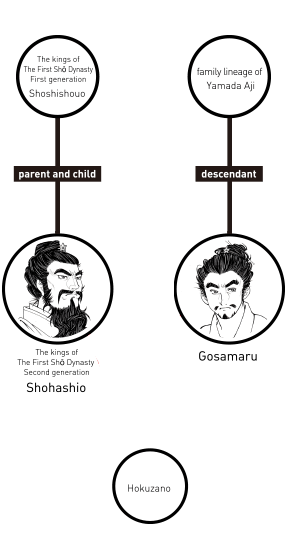
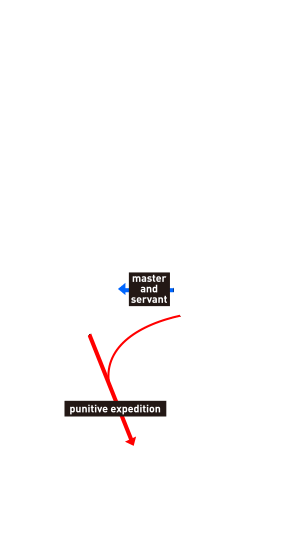
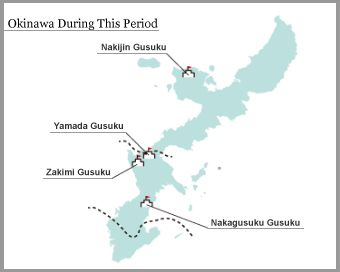
Key Events in Japan During This Period
1398 The Kinkaku of Rokuon-ji Temple in Kyoto wascompleted.
1399 The Ōei War
Key Events in the World During This Period
1411 “Eiraku-tsuho,” bronze coins began to be minted in the Ming Dynasty
1412 Joan of Arc was born.


Being Loyal: Gosamaru
in the Prime of His Life
After the Hokuzan Suppression, Gosamaru had been put in charge of Nakijin gusuku in Hokuzan for only a few years. This was because Shō Hashi ordered him to build a castle at Zakimi in Yuntanza and relocate there. Zakimi stands on a hill; therefore, the ground was less solid and it was not a suitable location for fortification. Despite its unfavorable condition, however, Gosamaru reused the ramparts of Yamada gusuku where he once served as aji and gathered workers, even from the remote islands, in order to complete Zakimi gusuku quicker than usual.
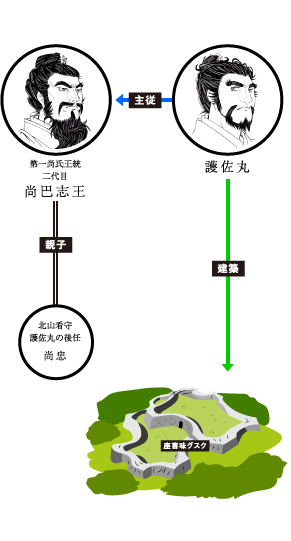
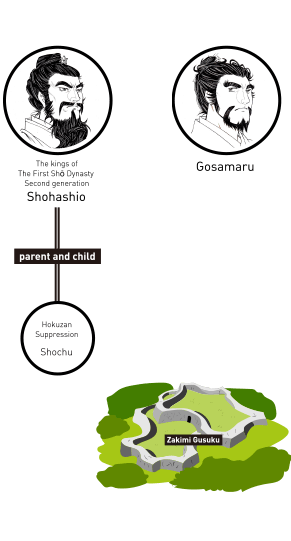

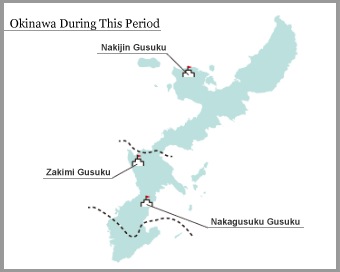
Key Events in Japan During This Period
1428 The Peasant Uprising of the Shocho Era
Cutting a Fine Figure:
Gosamaru in His Middle Age
Shō Hashi passed away in 1439, then Shō Chū was enthroned as the third king. This led Gosamaru to become Nakagusuku aji. It is said that this was “to keep an eye out for Katsuren aji, Amawari, who was expanding his power in Chūzan and to protect Shuri (the royal government).” At Nakagusuku Castle, Gosamaru constructed a reinforcement structure and a building extension to the existing castle, and he also secured a water source in preparation for a siege. At that time, he had consolidated his status by marrying off his daughter to Goeku aji who later became the sixth king, Shō Taikyū.
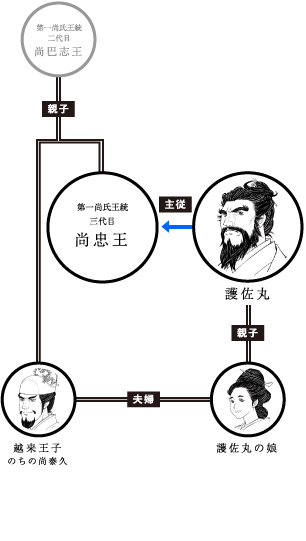
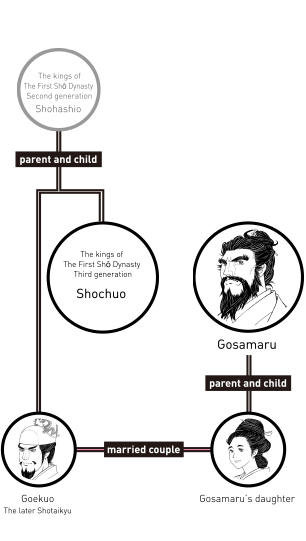


Key Events in Japan During This Period
1438年 The Eikyo Disturbance
1441年 The Kakitsu Disturbance
Key Events in the World During This Period
1431 Joan of Arc was executed.
1444 The Battle of Varna

Gosamaru in the Final
Stage of His Life
Successive changes of the king, and the “Shiro-Furi Disturbance” that resulted in thedestruction of Shuri Castle and Katsuren aji, Amawari’s expansion of his power,contributed to the growing tension in the Ryukyu Kingdom. After his enthronement, thesixth king, Shō Taikyū married off his own daughter, Momoto Fumiagari, who was alsothe granddaughter of Gosamaru, to Amawari in order to stabilize the kingdom.However, the so-called biggest mystery in the Ryukyu Kingdom era, the “Gosamaru-Amawari Disturbance” occurred.
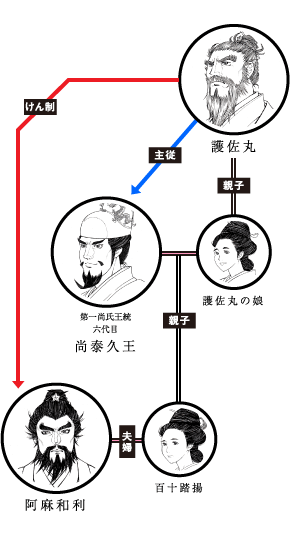
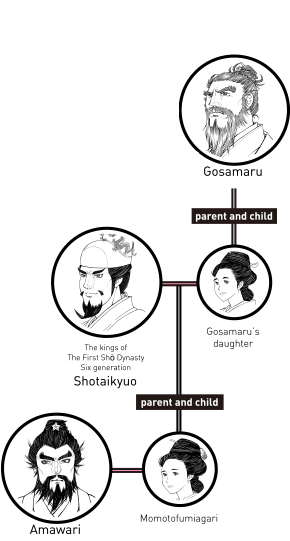
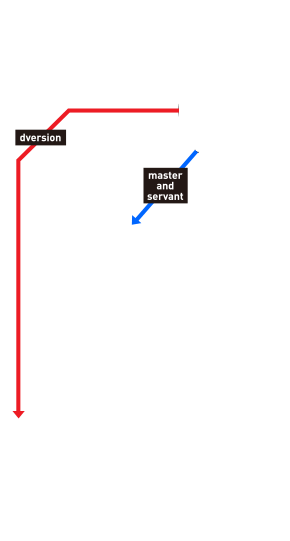
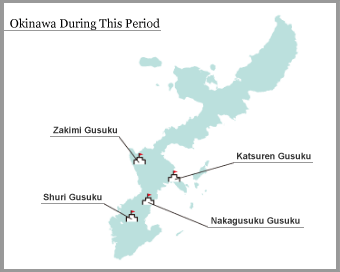
Key Events in Japan During This Period
1454 The Kyōtoku Incident
Key Events in the World During This Period
1452 Leonardo De Vinci was born.
1453 The Hundred Years' War ended.
1455 The Wars of the Roses

Why did the “Gosamaru-Amawari Disturbance” Occur?
According to one theory, it all began when Amawari told Shō Taikyū, who was the kingat that time, that “there was a suspicion of Gosamaru’s rebellion against the king.” ShōTaikyū was skeptical at first, but after he sent his vassals to scout out NakagusukuCastle, he discovered that Gosamaru had enforced a military build-up with weapons andtrained soldiers. Shō Taikyū viewed this as the “preparation for a rebellion,” and finallyhe ordered Amawari to suppress Gosamaru. The military build-up Gosamaru hadworked on was actually prepared for protecting the Shuri royal government fromAmawari whose growing presence in the Katsuren peninsula was becoming a threat.Unfortunately, however, the suspicion for treason was never cleared after all.
Coincidently, Nakagusuku Castle became the battleground for the “Gosamaru Suppression” which was fortified firmly by the massive ramparts. It is said that the royal army led by Amawari attacked Gosamaru in the midst of the Mid-Autumn Celebration. In haste, the vassals asked Gosamaru for permission to fight back; however, after they recognized the king’s flag, they decided not to fight against the king. As Gosamaru was faithful and had no intention of rebelling against the king, he ended up killing himself and his wife and children.
However, only the third son of Gosamaru, Morichika managed to escape from Nakagusku Castle with his nanny amid the disruption. After they escaped to the nanny’s hometown, Itoman, the Gosamaru family was eventually restored. Meanwhile, after he suppressed Gosamaru, Amawari even attempted to attack Shō Taikyū.
However, Momoto Fumiagari, who was the wife of Amawari and also the daughter of Shō Taikyū and the granddaughter of Gosamaru at the same time, and her vassal, Ufu Unigushiku discovered the plot, and Amawari was destroyed together with Katsuren Gusuku. This series of events led to the fall of Gosamaru and Amawari, the two major powers of the Ryukyu Kingdom outside of the royal government, at almost the same time.
After the “Gosamaru-Amawari Disturbance”
Shō Taikyū passed away after the “Gosamaru-Amawari Disturbance,” and Shō Toku was enthroned as the seventh king of the Ryukyu Kingdom. Shō Toku was a tyrant and the state of affairs in the kingdom began to deteriorate. After Shō Toku’s death, Kanemaru, who had been rejected by the royal government of Shuri, ascended to the throne in order to rebuild the Ryukyu Kingdom. He became the king Shō En and once he discovered that Morichika, the third son of Gosamaru was alive, he invited Morichika to the royal government.
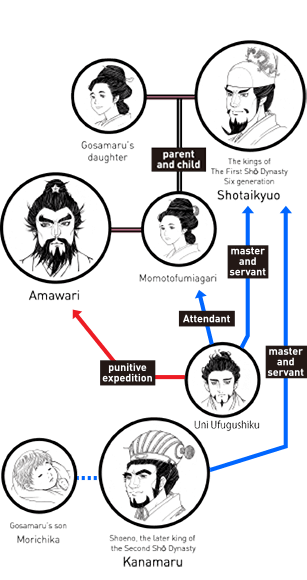
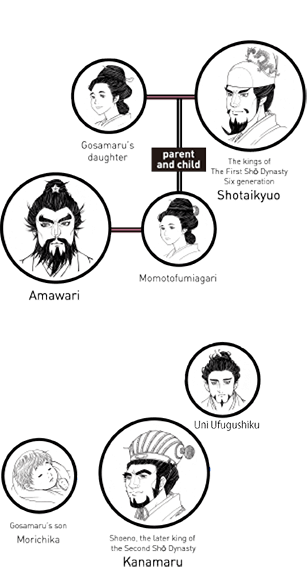

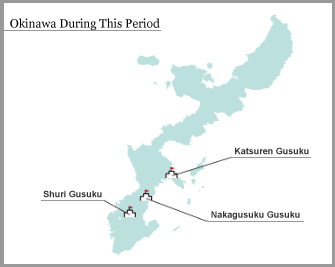
Key Events in Japan During This Period
1467 The Ōnin War
1582 The Honnō-ji Incident
Key Events in the World During This Period
1479 Establishment of the Kingdom of Spain
1644 The Fall of the Ming Dynasty

